Traffic3D Assets¶
Note: Most assets on this page have a prefab (a premade item) within the
Assets/Resources/Modelsfolder which can be copied or used an example to create / edit your own Assets.
Traffic Lights¶
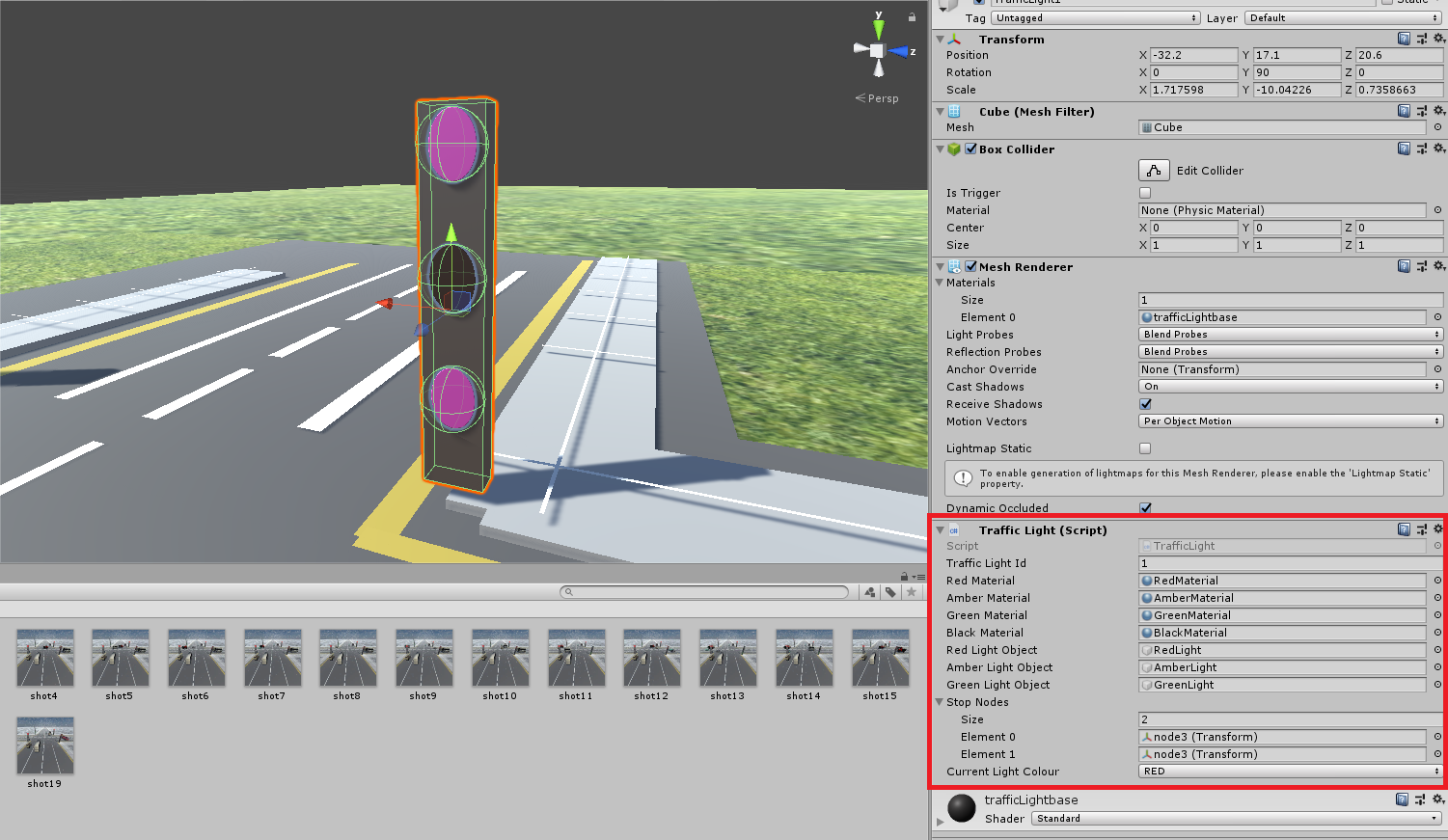
These are used to control traffic and are used within junctions, the script has the following fields:
- Traffic Light Id - The traffic light's unique number that identifies the traffic light.
- Red Material - The material of the red light when it is on.
- Amber Material - The material of the amber light when it is on.
- Green Material - The material of the green light when it is on.
- Black Material - The material of all lights when off.
- Red Light Object - The circle object for the red light (normally the top light).
- Amber Light Object - The circle object for the amber light (normally the centre light).
- Green Light Object - The circle object for the green light (normally the bottom light).
- Stop Nodes (List) - The nodes on multiple paths where the traffic light stops the vehicles (more on this later).
- Current Light Colour - The colour of the light that is currently on (e.g.
RED,AMBER,GREEN).
Vehicles¶
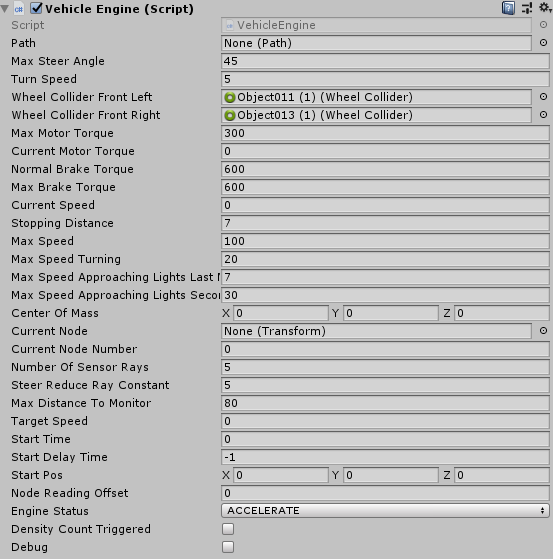
The script has the following fields:
- Path - The path that will be taken by the vehicle.
- Max Steer Angle - The maximum angle at which the vehicle will turn.
- Turn Speed - The speed at which the wheels will turn.
- Wheel Collider Front Left - The collider of the front left wheel.
- Wheel Collider Front Right - The collider of the front right wheel.
- Max Motor Torque - The maximum torque of the engine in a forward direction.
- Current Motor Torque - The current torque of the engine in a forward direction.
- Normal Brake Torque - The torque which the vehicle will normally use for slowing down.
- Max Brake Torque - The maximum torque which the vehicle will normally use for slowing down.
- Current Speed - The current speed of the vehicle.
- Stopping Distance - The distance at which a sensor will signal the vehicle to stop when an object is in front of it.
- Max Speed - The maximum speed of the vehicle.
- Max Speed Turning - The maximum speed of the vehicle when turning.
- Max Speed Approaching Lights Last Node - The maximum speed of the vehicle when approaching the last node from the traffic lights.
- Max Speed Approaching Lights Second Last Node - The maximum speed of the vehicle when approaching the second to last node from the traffic lights.
- Centre Of Mass - The centre of mass of the vehicle.
- Current Node - The current node of the path the vehicle is on.
- Current Node Number - The current node number of the path the vehicle is at.
- Number of Sensor Rays - The number of Sensor rays on the front of the vehicle.
- Max Distance To Monitor - The maximum distance for the sensor rays to monitor.
- Target Speed - The current target speed of the vehicle.
- Start Time - The time the vehicle is spawned in at.
- Start Delay Time - The time when the vehicle has started at the junction.
- Start Pos - The position the vehicle is spawned in at.
- Node Reading Offset - The forward offset of the node reader for paths.
- Engine Status - The status of the Engine currently (e.g.
ACCELERATE,STOP,HARD_STOP). - Density Count Triggered - Checked when the vehicle has passed the density measurement point.
- Debug - Shows debug information (currently displays the rays from the sensor).
Only the following fields should be filled in, the rest of the fields are filled during the simulation:
- Max Steer Angle
- Turn Speed
- Wheel Collider Front Left and Right
- Max Motor Torque
- Normal Brake Torque
- Max Brake Torque
- Max Speed
- Max Speed Turning
- Max Speed Approaching Lights Last Node
- Max Speed Approaching Lights Second Last Node
- Centre Of Mass
- Number of Sensor Rays
- Max Distance To Monitor
- Node Reading Offset
- Debug
Most of these options can be left at their default values.
Vehicle Factory¶
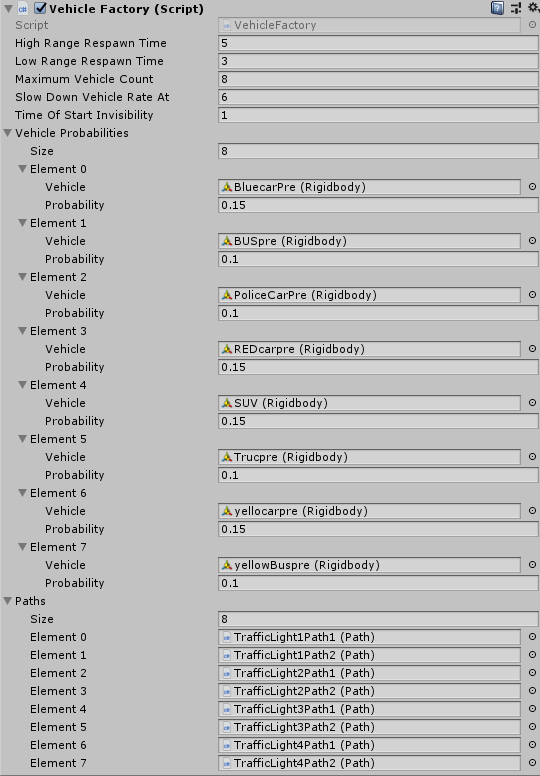
The Vehicle Factory Script has the following fields:
- High Range Respawn Time - The maximum time in simulation seconds for the next vehicle to re-spawn.
- Low Range Respawn Time - The minimum time in simulation seconds for the next vehicle to re-spawn.
- Maximum Vehicle Count - The maximum number of vehicles allowed to be in the scene at once.
- Slow Down Vehicle Rate At - The number of vehicles in the scene where the rate of spawn will slow down after this number.
- Time Of Start Invisibility - The amount of time at the start where the spawned vehicle is invisible.
- Vehicle Probability (List) - A list of Vehicles with the percentage probability of them spawning next. Use this add extra Vehicles.
- Vehicle - The rigidbody of the vehicle.
- Probability - The probability between
0.0 - 1.0of the vehicle spawning.
- Paths (List) - The list of paths that have been placed in the scene.
Pedestrian Point¶
Transforms the position at which pedestrians spawn / go to with the PedestrianPoint.cs script attached.
Pedestrians¶
Pedestrians will walk around the scene by spawning at Pedestrian Points and moving towards another Pedestrian Point as their destination.
Models can be created and edited.
The Pedestrian Factory will allow multiple models to be added with a probability of the model spawning.
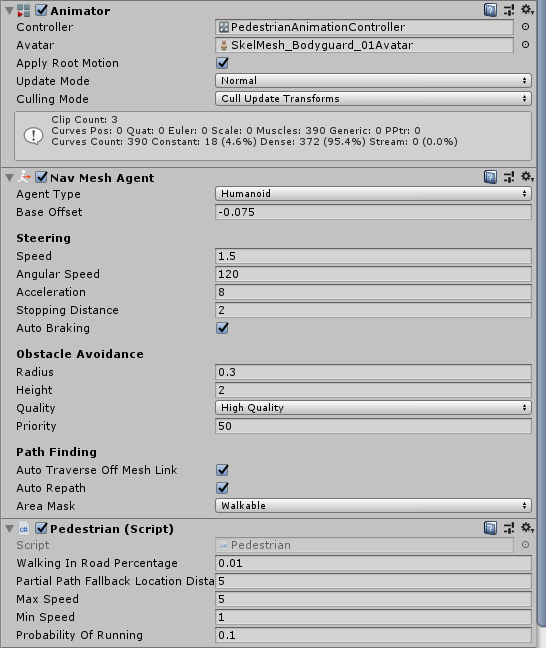
The Pedestrian.cs Script has the following fields:
- Walking In Road Percentage - The chance of the pedestrian walking into the road to reach their destination.
- Partial Path Fallback Location Distance - This probably won't be edited as much but this is the distance a pedestrian will look around for an original path node to walk back to if their path is suddenly partial (which mainly happens when crossings are turned off) almost like a safe spot for the pedestrian to stand. If no original nodes are found, then they will stand where they are.
- Max Speed - This is the maximum range of speed they will start with.
- Min Speed - The minimum speed.
- Probability of Running - The probability that the pedestrian's speed will be over the set running speed.
There is also a Nav Mesh Agent Component that can be edited too (except for speed as that is decided by the Pedestrian script) which can be found here: https://docs.unity3d.com/Manual/class-NavMeshAgent.html
When creating a pedestrian there are examples within the Assets/Resources/Models/Pedestrians/ folder which can be cloned and used to create new models.
Pedestrian Crossings¶
The crossing is used by pedestrians to allow them to cross at relevant times.
A pedestrian will wait until the crossing allows the pedestrian to cross which are normally changed in a Junction State.
PedestrianCrossing.cs has the following fields:
- Pedestrian Crossing ID – A unique ID to identify the crossing from others.
- Pedestrian Currently in Crossing Area - The current pedestrians in the area of the crossing.
- Allow Crossing - A boolean, when true, allows pedestrians to cross roads.
Pedestrian Factory¶
Creates the pedestrians in the simulation, the script has the following fields:
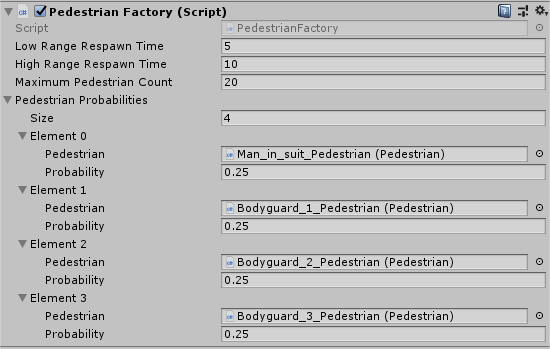
- Low Range Respawn Time - Lower range for a random time to be generated for the next pedestrians to spawn in simulation seconds (similar to Vehicle respawn time).
- High Range Respawn Time - The upper range of above in simulation seconds.
- Maximum Pedestrian Count - The max number of pedestrians that can be in the simulation at once.
- Pedestrian Probabilities (List) - A list of pedestrian models with the percentage probability of them spawning next. Use this add extra Pedestrian Models.
- Pedestrian - The Pedestrian.
- Probability - The probability between
0.0 - 1.0of the pedestrian spawning.
Pedestrian Manager¶
This mainly runs in the background, determining which surfaces are roads or pathways for the pedestrians. It also holds a list of the crossings.
Paths¶
Paths are used by vehicles to reach their destination.
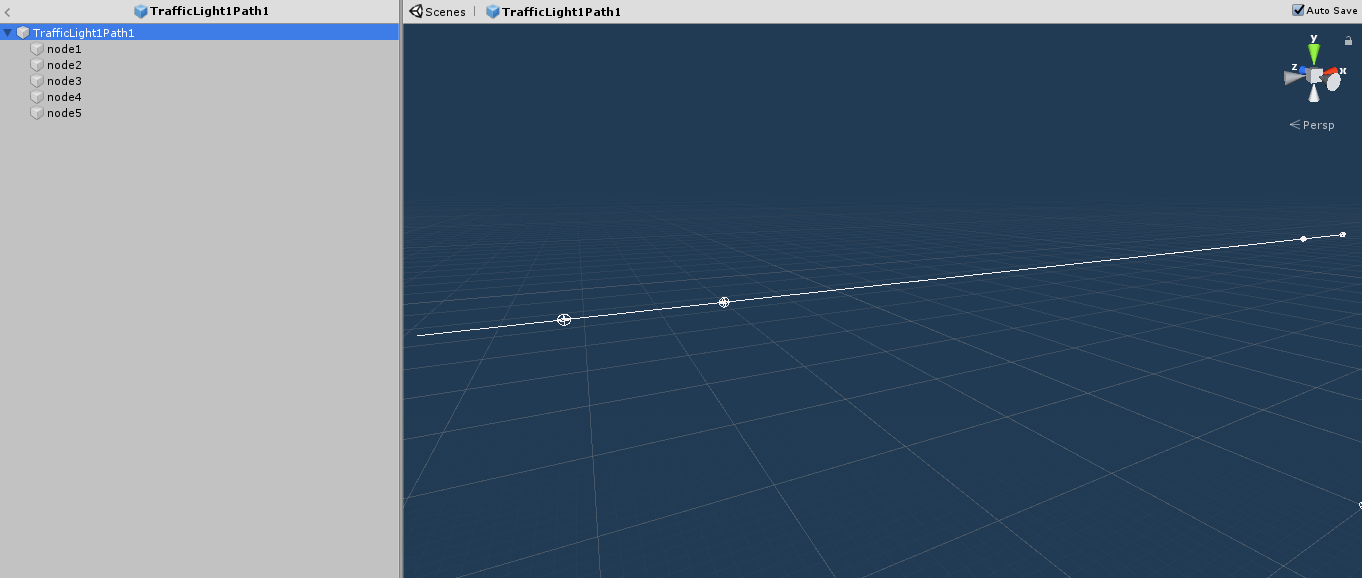
Each node represents a point along the path.
The vehicle will follow from node1 (the spawn point) to the last node which in this case is node5 where the vehicle will be destroyed.
If there is a traffic light on the path, a node (also known as a stop node) will have to be placed at the traffic light which can be easily done by either moving an existing node or creating a new one by copying and pasting a node and moving that node to the correct location (make sure the nodes are still in the correct order and all following nodes are renamed to the correct number).
This node will be where the vehicle stops for that traffic light.
Make sure that all paths are above ground but not too high so first node can spawn the vehicle.
To measure density, the Density Measurement Point will need to be placed on one of the nodes which normally is after a junction.
Once the script is attached, a collider with Is Trigger checked needs to also be attached to the node game object which should be big enough to detect vehicles passing through.
Junctions¶
Junctions are a collection of traffic lights and pedestrian crossings which are controlled by set states. For example, in:
- Junction State 1 - Traffic Light A is Green, Traffic Light B is Red, Pedestrian Crossing C is disallowing crossings.
- Junction State 2 - Traffic Light A is Red, Traffic Light B is Green, Pedestrian Crossing C is disallowing crossings.
- Junction State 3 - Traffic Light A is Red, Traffic Light B is Red, Pedestrian Crossing C is allowing crossings.
A junction will be in only one state at a time and will change states when needed via the AI program or built-in demo. The Junction script has the following fields:
- Junction ID – A unique ID to identify the junction from others.
- Junction Camera – The camera which is assigned to the junction and is used for the AI script to set an action which is changing the Junction State.

Junction States are Game Objects assigned to the parent Game Object with the Junction Script attached.
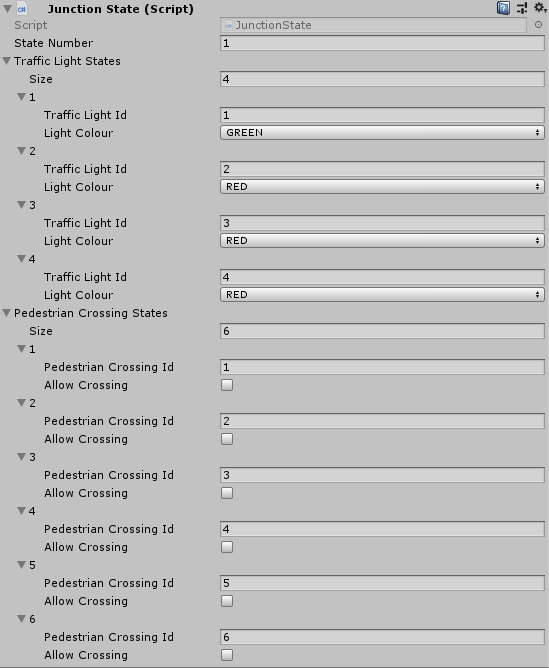
The Junction State script has the following fields:
- State Number – The number of the state which is unique to the Junction to identify the other states.
- Traffic Light States (List) – A list of the different traffic lights within the junction that need to change on this current state.
- Traffic Light Id – The traffic light ID to change.
- Light Colour – The colour for the traffic light to change to.
- Pedestrian Crossing States (List) – A list of the different Pedestrian Crossings within the junction that needs to change on the current state.
- Pedestrian Crossing Id – The pedestrian crossing ID to change.
- Allow Crossing – A Boolean which if checked will allow a pedestrian to cross on the selected pedestrian crossing during the state.
Note: Any Traffic Lights or Crossings that are missing off the list will stay in the same state.
Environment Settings¶
With Environment Settings, rain, snow, and night can be toggled, different lighting can be set, and surface friction can be changed too.
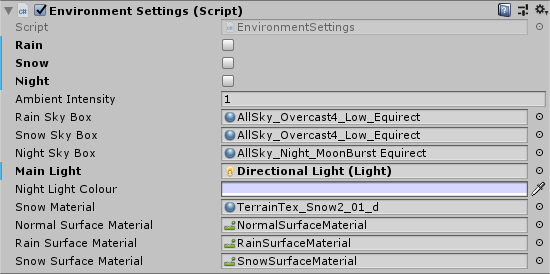
The Environment Settings script has the following fields:
- Rain – A Boolean to toggle Rain on and off.
- Snow – A Boolean to toggle Snow on and off.
- Night – A Boolean to toggle Night on and off.
- Ambient Intensity – The current lighting intensity of the scene.
- Rain Sky Box – The sky box to be used when Rain is toggled.
- Snow Sky Box – The sky box to be used when Snow is toggled (overrides rain sky box when rain and snow is toggled).
- Night Sky Box – The sky box to be used when Night is toggled (overrides rain and / or snow sky box when both or each of them are toggled with night being toggled too).
- Main Light – The main light within the scene.
- Night Light Colour – The colour of the main light when night has been toggled.
- Normal Surface Material – The physics material used as default.
- Rain Surface Material – The physics material to be used when raining.
- Snow Surface Material – The physics material to be used when snowing.
The physics material can be found in /Assets/Resources/Materials/PhysicMaterials and friction values can be changed within those objects.
Python Manager¶
Python Manager manages the connection between the AI Python script and Traffic3D.
A loop is created to train the AI.
First the manager takes screenshots using all the junction cameras in the scene.
The screenshots are sent to the Python script for it to process, once processed the Python script sends the actions back for each Junction in the scene, this action is the junction state number that the junction needs to change to.
Density and Flow is then calculated and outputted in the /Assets/Results/ folder.
Rewards are then sent to the Python script for the script to process.
Click here learn more about the Python script.
Sumo Manager¶
This manages the connection between SUMO and Traffic3D and allows different software to control different features. Click here learn more about SUMO and how to connect to SUMO.
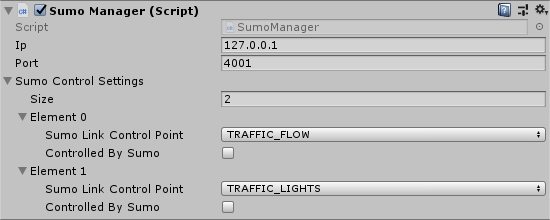
The Sumo Manager Script has the following fields:
- Ip – The IP address of the SUMO instance
- Port – The port of the SUMO instance
- Sumo Control Settings (List) – A list of the different control points that can be controlled by either Traffic3D or SUMO
- Sumo Link Control Point – The setting to control.
- Controlled by Sumo – A Boolean which if true means that the above setting is controlled with SUMO
Real Time Graphs¶
Graphs display on screen with real-time data about the simulation. These can be toggled at the start and in mid simulation. Currently there are three graphs:
- Time-Travelled – The amount of time it has taken a vehicle to travel the full distance of the journey.
- Throughput – The number of vehicles that has completed the journey during a single simulation time step.
- Delay – The amount of time it has taken for a vehicle to pass a junction.
The Graph Manager script has a Boolean field for each of the graphs above to toggle them on and off.
Camera Manager¶
This object takes the screenshots for the Python Script and also controls the frame-rate for the scene.
It has the following field:
- Frame Rate - Speeds up the simulation when lower, see the Unity API documentation for more information.